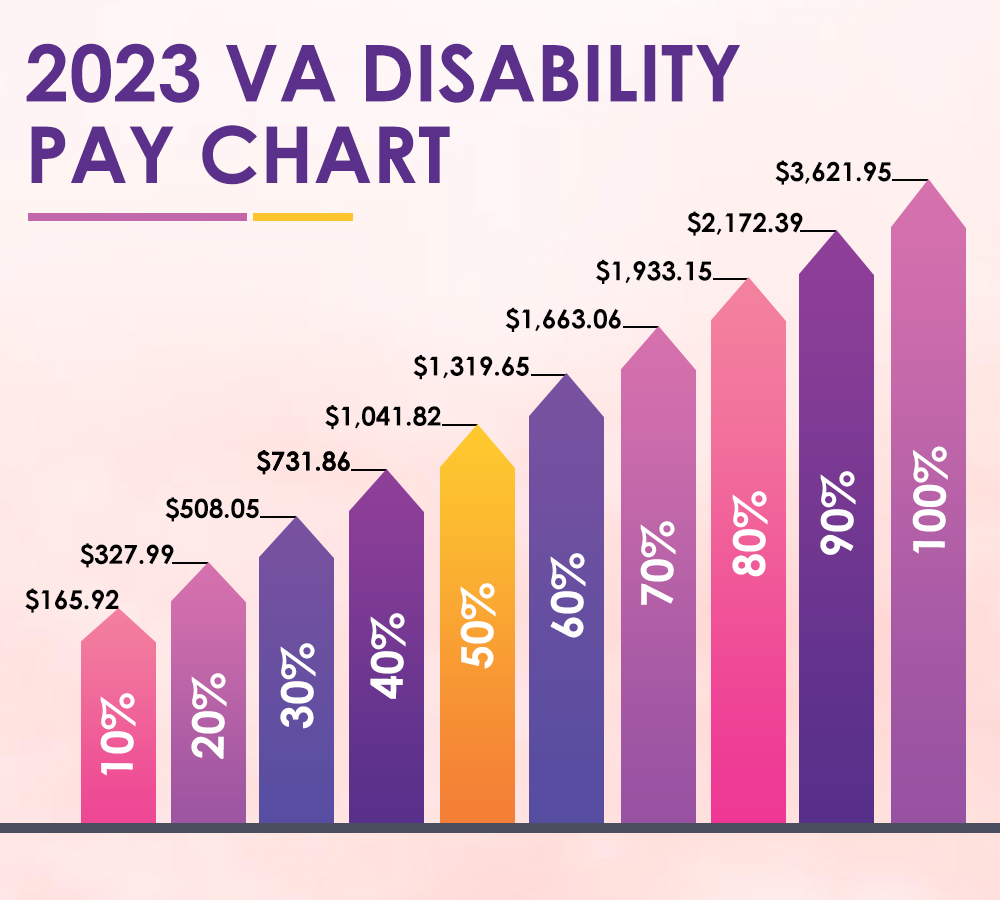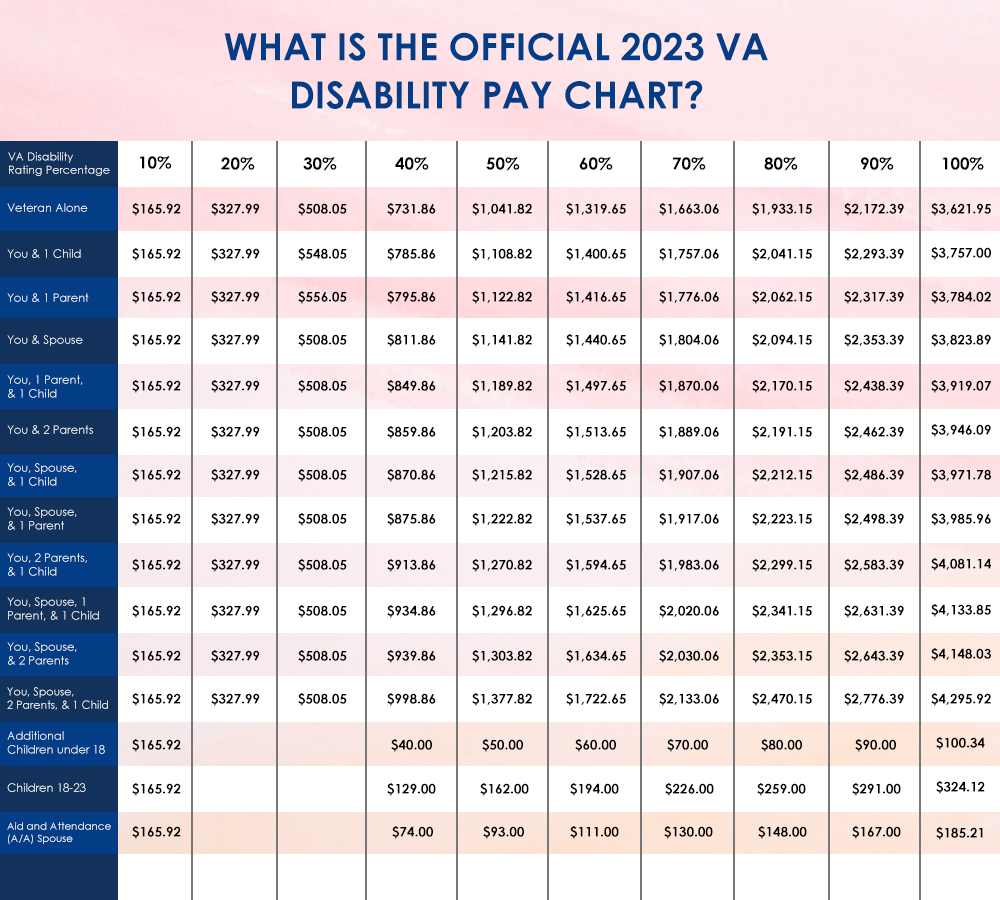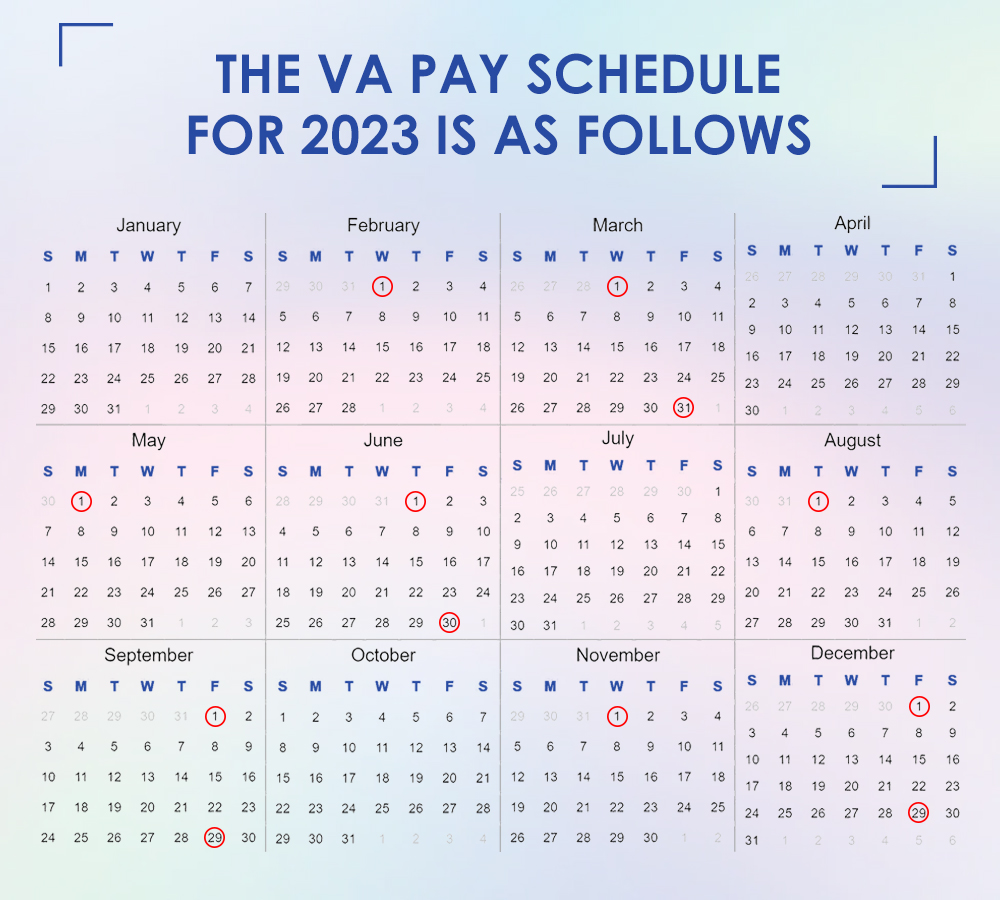2023 VA Disability Pay Rates Chart and Schedule Dates
VA Disability refers to the compensation and benefits provided by the United States Department of Veterans Affairs (VA) to eligible veterans who have service-connected disabilities. These disabilities are conditions or injuries that were incurred or aggravated during military service.
VA Disability benefits can include monthly disability compensation payments, healthcare, vocational rehabilitation and employment services, education and training assistance, home loan guarantees, life insurance, and more.
The amount of compensation a veteran may receive for their service-connected disabilities is determined by the VA’s Schedule for Rating Disabilities, which assigns a percentage rating to each disability based on its severity. The percentage ratings for each disability are then combined to determine the veteran’s overall combined disability rating, which is used to determine the amount of monthly compensation they are eligible to receive.
Veterans who have service-connected disabilities should apply for VA Disability benefits as soon as possible to ensure that they receive the compensation and benefits they are entitled to.

How Much Are 2023 Monthly VA Disability Payments?
The amount of monthly VA Disability payments varies depending on the veteran’s combined disability rating, which is a percentage assigned by the Department of Veterans Affairs (VA) based on the severity of the veteran’s service-connected disabilities.
As of 2021, the monthly VA Disability compensation rates range from $144.14 for a veteran with a 10% disability rating to $3,146.42 for a veteran with a 100% disability rating. However, the amount of compensation can be higher for veterans with dependents, such as spouses, children, or parents who are dependent on the veteran for support.
It is important to note that these rates are adjusted annually based on changes in the cost of living, and they may vary depending on the veteran’s individual circumstances and eligibility status. Additionally, veterans who receive disability compensation payments may be eligible for additional benefits, such as healthcare, education and training assistance, vocational rehabilitation and employment services, and more.
If you are a veteran with service-connected disabilities and are unsure of the amount of compensation you are eligible to receive, you can contact the VA or work with a Veterans Service Organization or VA-accredited attorney for assistance in navigating the disability compensation system.
As of 2023, the monthly VA Disability compensation rates range from $165.92 for a veteran with a 10% disability rating to $3621.95 for a veteran with a 100% disability rating.

What is the VA Disability Pay Schedule for 2023?
The VA Disability Pay Schedule is the schedule of dates on which the Department of Veterans Affairs (VA) makes monthly disability compensation payments to eligible veterans. The VA typically issues disability compensation payments on the first business day of each month.
However, the specific day on which you receive your payment can vary depending on a number of factors, including the payment method you have chosen (e.g. direct deposit or check), your bank’s processing times, and any holidays or weekends that may affect the payment schedule.
To ensure that you receive your disability compensation payment on time, it is important to keep your contact and banking information up to date with the VA, and to notify them promptly if you experience any changes in your eligibility status or other circumstances that may affect your payment.
You can also check the VA’s payment calendar to see the dates on which payments are scheduled to be issued each month, and to find information about any upcoming changes or updates to the payment schedule.

How Are VA Disability Payments Calculated?
VA disability payments are calculated based on a combination of factors, including the severity of your service-connected disabilities, the number of dependents you have, and the current VA disability compensation rates.
The first step in calculating your VA disability payment is to determine your combined disability rating, which is a percentage that represents the overall severity of your service-connected disabilities. This rating is based on the VA’s Schedule for Rating Disabilities, which assigns a specific percentage rating to each disability based on its severity.
Once your combined disability rating has been determined, the VA will use it to calculate your monthly disability payment. The VA disability compensation rates are adjusted annually based on changes in the cost of living, and they vary depending on your combined disability rating and the number of dependents you have.
In addition to the basic disability compensation, the VA may provide additional compensation for special circumstances, such as the need for aid and attendance, or for dependents, such as a spouse or children.
It is important to note that VA disability payments are tax-free and do not affect your eligibility for other government benefits, such as Social Security disability benefits.
How Long Does VA Retroactive Pay Take?
The length of time it takes to receive retroactive pay from the VA can vary based on a number of factors, including the complexity of your case, the amount of retroactive pay owed, and how quickly the VA is able to process your claim. In general, the VA strives to process retroactive pay claims as quickly as possible, but it can take several months or even longer in some cases.
Once your claim for retroactive pay has been approved, the VA will calculate the amount of back pay you are owed and will issue a lump sum payment. The length of time it takes to receive this payment can also vary, but it typically takes a few weeks to a few months for the payment to be processed and issued.
If you are experiencing financial hardship and need your retroactive pay sooner, you can contact the VA and request an expedited payment. Additionally, working with a Veterans Service Organization or a VA-accredited attorney can help ensure that your retroactive pay claim is processed as quickly as possible.
How Can I Increase My Monthly VA Disability Payment?
There are several ways to potentially increase your monthly VA disability payment:
- File for an increase in disability rating: If your disability has worsened or if you have developed new disabilities, you can file for an increase in disability rating. You will need to provide medical evidence to support your claim.
- File for Individual Unemployability (IU): If your service-connected disabilities make it impossible for you to maintain gainful employment, you can file for IU. IU pays at the 100% rate even if your combined disability rating is less than 100%.
- File for Secondary Service Connection: If you have a non-service-connected disability that is caused or worsened by a service-connected disability, you can file for secondary service connection. This can increase your disability rating and therefore your monthly payment.
- Dependents: If you have dependents such as a spouse or children, you may be eligible for additional compensation. This is known as a dependent allowance.
- Special Monthly Compensation (SMC): If you have very severe disabilities such as loss of use of limbs or blindness, you may be eligible for SMC. SMC is a higher rate of compensation that is paid in addition to your regular disability compensation.
It is important to note that in order to receive an increase in your monthly VA disability payment, you will need to provide evidence to support your claim. This can include medical records, statements from doctors or other medical professionals, and other documentation related to your disabilities.


